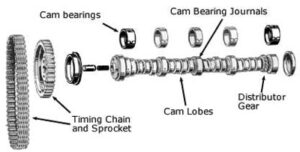Introduction 
A camshaft is a metallic tube with lobes made of cast iron used in engines to operate the intake and exhaust valves. The first-ever camshaft was made in 1206 by Al-Jazari and it was used to operate his water-powered castle clock. (Edubilla, p. 1). Ever since these camshafts were used to operate a plethora of machines and in 1902 it was used for the first time in a car by Maudslay Motor Company. (Edubilla, p. 1).
In March of 1984, Honda was trying to separate themselves in the automotive market thus Honda’s New Concept Engine was born. Ikuo Kajitani was employed to create these new-age engines and in his mind, he wanted a mechanism that can alter the timings of the valves. Katijani said, “four-valve engines are known as high-revving, high-output machines. And for that reason, we knew it would be quite difficult to achieve low-end performance if the engine’s displacement were too small.” (Honda Global, p. 1). Honda was struggling to find a balance between performance at low RPMs without sacrificing high RPM power and their impressive miles per gallon that Honda engines were known for. Original ideas for finding this balance were catastrophic such as reducing the valve’s interior angle which resulted in the timing belt breaking at high RPMs.
In 1982 a group of Honda engineers was looking into “the idea switchable valve timing” to improve gas mileage, piggybacking from their research the NCE program though that adding “a new set of cam followers and rocker arms for high-speed operation on the intake and exhaust sides would help, along with the switching of cam hills according to engine speed.”. (Honda Global, p. 1) This was originally called “valve stopping + variable valve timing” and it underwent study by the NCE program and Honda’s research team and thus VTEC was born and first introduced in the 1989 Integra.
How A Camshaft Works 
Camshafts are made of four main components, the main journal, the lobes, the ends, and the bearings. Each part has its own purpose and they are essential to the performance of the engine, in VTEC engines there are two camshaft profiles and nowadays there are sometimes even three camshaft profiles in order to have peak performance in each rev range.
The main journal is the main structure of the camshaft which is connected to the head of the engine. It is usually made of cast iron because it is essential that it does not break, and it is resistant to high heat. On the main journal, there are the cam lobes which open and close the intake and exhaust valves in time with the motion of the piston. Cam lobes control the valve lift, and typically the bigger the cam lobes are the more power you get because more oxygen gets in the combustion chamber and more oxygen means a bigger explosion. The camshaft also has bearings that allow it to rotate and it gives the camshaft space to expand while it is hot. In a camshaft there are two ends, “The front end of the cam secures the vehicle’s timing belt and keeps it in time with the crankshaft” and “the rear end of the cam turns the distributor of the engine with a special gear. This part keeps the ignition timing in tune with the rest of the engine.”. (Bailey, 2019, p. 1).
Parts of A Cam Lobe 
Typically, the main journal, the cam bearings, and the ends are the same on all engines, but the cam lobes are what makes each camshaft unique and perform differently from one another. The cam lobe is made up of 6 main parts: the clearance ramp, the closing ramp, the nose, the opening ramp, the base circle, and the lobe centerline. The base circle is the backside of the lobe and it is where the valve is closed and the size of it is important usually people go for a smaller base circle as it “allows more lobe lift, but it can also allow the camshaft to flex and throw off the timing events.” Hotrod, p. 1). The opening ramp raises the lifter, and the closing ramp lowers the lifter and in between these two stages is the clearance ramp. The nose is the top part of the lobe that holds the valve open as it opens and closes, and the lobe centerline is the highest point of the lobe. (Summit Racing, p. 1). A cam lobe can also be different shapes such as round, egg-shaped, ellipse, eccentric, hexagon, and snail. (Energy Education, p. 1).
Conclusion 
The camshaft was created hundreds of years ago harnessing the power of rotational energy to power things. In the 1980s Honda wanted to stand out in the car world, they wanted more power without losing low-end torque and without losing their impressive miles per gallon that they were known for. Honda deployed a team specifically trying to find something to make themselves stand out and this is when Honda’s variable valve timing or VTEC was born. This allows low-end power and high gas mileage and high-end power if you chose to go fast. There are many parts of a camshaft and the parts of the camshaft have parts themselves and changing any of these will create differences in power. At the end of the day, people will continue experimenting with new camshaft designs to get the extra bit of power. People may say they are done modifying their car, but it is usually never enough, and you can usually catch them going for more power.
References
Honda Global: The VTEC Engine / 1989. (n.d.). Retrieved October 22, 2020, from https://global.honda/heritage/episodes/1989vtecengine.html
Camshaft,Camshaft inventors. (n.d.). Retrieved October 22, 2020, from http://www.edubilla.com/invention/camshaft/
Bailey, E. (2019, January 10). Parts of a Camshaft. Retrieved October 22, 2020, from https://itstillruns.com/parts-camshaft-7483156.html
What are the parts of a camshaft lobe? (2019, November 12). Retrieved October 27, 2020, from https://help.summitracing.com/app/answers/detail/a_id/5166/~/what-are-the-parts-of-a-camshaft-lobe
https://www.hotrod.com/articles/ctrp-0701-camshaft-design-science/#:~:text=The%20cam%20lobes%20control%20not,pressure%20is%20developed%20at%20speed.&text=When%20the%20lifter%20is%20on,the%20heel%20of%20the%20lobe.
Cam. (n.d.). Retrieved October 27, 2020, from https://energyeducation.ca/encyclopedia/Cam


